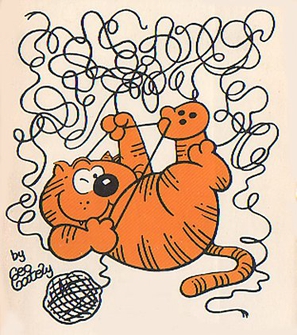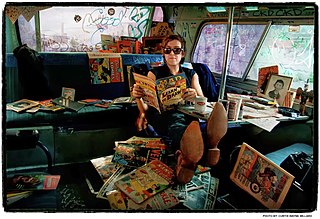Related Research Articles

A comic strip is a sequence of cartoons, arranged in interrelated panels to display brief humor or form a narrative, often serialized, with text in balloons and captions. Traditionally, throughout the 20th and into the 21st century, these have been published in newspapers and magazines, with daily horizontal strips printed in black-and-white in newspapers, while Sunday papers offered longer sequences in special color comics sections. With the advent of the internet, online comic strips began to appear as webcomics.

Garfield is an American comic strip created by Jim Davis. Originally published locally as Jon in 1976, then in nationwide syndication from 1978 as Garfield, it chronicles the life of the title character Garfield the cat, his human owner Jon Arbuckle, and Odie the dog. As of 2013, it was syndicated in roughly 2,580 newspapers and journals and held the Guinness World Record for being the world's most widely syndicated comic strip.

The Yellow Kid is an American comic strip character that appeared from 1895 to 1898 in Joseph Pulitzer's New York World, and later William Randolph Hearst's New York Journal. Created and drawn by Richard F. Outcault in the comic strip Hogan's Alley, it was one of the first Sunday supplement comic strips in an American newspaper, although its graphical layout had already been thoroughly established in political and other, purely-for-entertainment cartoons. Outcault's use of word balloons in the Yellow Kid influenced the basic appearance and use of balloons in subsequent newspaper comic strips and comic books.

The Far Side is a single-panel comic created by Gary Larson and syndicated by Chronicle Features and then Universal Press Syndicate, which ran from December 31, 1979, to January 1, 1995. Its surrealistic humor is often based on uncomfortable social situations, improbable events, an anthropomorphic view of the world, logical fallacies, impending bizarre disasters, references to proverbs, or the search for meaning in life. Larson's frequent use of animals and nature in the comic is popularly attributed to his background in biology. The Far Side was ultimately carried by more than 1,900 daily newspapers, translated into 17 languages, and collected into calendars, greeting cards, and 23 compilation books, and reruns are still carried in many newspapers. After a 25-year hiatus, in July 2020 Larson began drawing new Far Side strips offered through the comic's official website.

Guy Berkeley "Berke" Breathed is an American cartoonist, children's book author, director, and screenwriter, known for his comic strips Bloom County, Outland, and Opus. Bloom County earned Breathed the Pulitzer Prize for Editorial Cartooning in 1987.
Tom the Dancing Bug is a weekly satirical comic strip by cartoonist and political commentator Ruben Bolling that covers mostly US current events from a liberal point of view. Tom the Dancing Bug won the 2002, 2003, 2007, 2008, and 2009 Association of Alternative Newsweeklies Awards for Best Cartoon. The strip was awarded the 2010 Sigma Delta Chi Award for editorial cartooning by the Society of Professional Journalists and best cartoon in the 2018 Robert F. Kennedy Book & Journalism Awards. His work on the strip won Bolling the 2017 Herblock Prize and the 2021 Berryman Award for Editorial Cartoons, and he was a finalist in the Editorial Cartooning category for the 2019 and 2021 Pulitzer Prize.

Cathy is an American gag-a-day comic strip, drawn by Cathy Guisewite from 1976 until 2010. The comic follows Cathy, a woman who struggles through the "four basic guilt groups" of life—food, love, family, and work. The strip gently pokes fun at the lives and foibles of modern women. The strip's debut was on November 22, 1976, and appeared in over 1,400 newspapers at its peak. The strips have been compiled into more than 20 books. Three television specials were also created. Guisewite received the National Cartoonists Society Reuben Award in 1992 for the strip.

Nancy is an American comic strip, originally written and drawn by Ernie Bushmiller and distributed by United Feature Syndicate and Andrews McMeel Syndication. It was spun off from Fritzi Ritz, a strip Bushmiller inherited from creator Larry Whittington in 1925. After Fritzi's niece Nancy was introduced in 1933, Fritzi Ritz evolved to focus more and more on Nancy instead of Fritzi. The new strip took the old one's daily slot, while Fritzi Ritz continued as a Sunday, with Nancy taking the Sunday slot previously filled by Bushmiller's Phil Fumble strip beginning on October 30, 1938.

Heathcliff is an American comic strip created by George Gately in 1973, featuring the title character, an orange cat. Now written and drawn by Gately's nephew, Peter Gallagher, it is distributed to over 1,000 newspapers by Creators Syndicate, which took over the comic from McNaught Syndicate in 1988.
Rhymes with Orange is an American comic strip written and drawn by Hilary B. Price and distributed by King Features Syndicate. The title comes from the commonly held belief that no word in the English language rhymes with "orange". It was first syndicated in June 1995.
9 Chickweed Lane is an American comic strip written and drawn by Brooke McEldowney for over 30 years, which follows the fortunes of the women of three generations of the Burber family: Edna, Juliette, and Edda. 9 Chickweed Lane is the address of the characters' former family home. There is occasional overlap of characters between 9 Chickweed Lane and another comic by McEldowney, Pibgorn.
Fred Basset is a comic strip about a male basset hound. The cartoon was created by Scottish cartoonist Alex Graham and published first in the Daily Mail on 8 July 1963.

Ask Shagg was a syndicated daily comic strip drawn by cartoonist Peter Guren from 1980 to 2020. It was distributed by Creators Syndicate; it had been distributed by United Feature Syndicate from 1980 until 1995. The strip has run in dozens of newspapers including The Boston Globe, The Columbus Dispatch, and the Seattle Post-Intelligencer. In each strip Guren, through his Shagg E. Dawg character, answered questions from readers about the animal kingdom. The strip retired on the 5th of January, 2020.

Pooch Café is a Canadian-American gag-a-day comic strip written and illustrated by Paul Gilligan. It was also made into a series of online shorts with RingTales.

Michael M. Wartella is an American underground cartoonist, animator, writer and director based in New York City, generally publishing under the name M. Wartella or just Wartella. He is best known for his work in The Village Voice and on Cartoon Network's MAD.

Krazy Kat is an American newspaper comic strip, by cartoonist George Herriman, which ran from 1913 to 1944. It first appeared in the New York Evening Journal, whose owner, William Randolph Hearst, was a major booster for the strip throughout its run. The characters had been introduced previously in a side strip with Herriman's earlier creation, The Dingbat Family. The phrase "Krazy Kat" originated there, said by the mouse by way of describing the cat. Set in a dreamlike portrayal of Herriman's vacation home of Coconino County, Arizona, KrazyKat's mixture of offbeat surrealism, innocent playfulness and poetic, idiosyncratic language has made it a favorite of comics aficionados and art critics for more than 80 years.
Working Daze is a comic strip written by John Zakour that centers around the working relationships of a group of mostly geeks who work for MMM, a D list giant, impersonal software/tech company.
Compu-toon is a comic strip by Charles Boyce.
Charles Boyce, is an American cartoonist known for his syndicated comic panel Compu-toon. Boyce is also known for creating the KeyPad Kid, a cartoon character used in public affairs awareness programs for training within the telecommunication industry.
In the Bleachers is a comic strip that comments on, and lampoons, sports. It was created in 1985 by American cartoonist/filmmaker Steve Moore and is currently syndicated internationally by Andrews McMeel Syndication.
References
- ↑ "Graham Harrop | Cartoonist | Plant Series cards | Custom Cartoons for Professions". grahamharrop.com. Retrieved 2022-08-17.
- ↑ "Today on Ten Cats - Comics by Graham Harrop - GoComics". www.gocomics.com. Retrieved 2022-08-17.